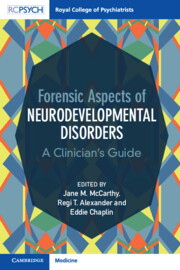Book contents
- Forensic Aspects of Neurodevelopmental Disorders
- Forensic Aspects of Neurodevelopmental Disorders
- Copyright page
- About the Cover Page
- Contents
- Contributors
- Foreword by the Rt Hon Lord Bradley
- Terminology Used in the Book
- Section 1 An Overview: Definitions, Epidemiology and Policy Issues
- Section 2 Assessment and Therapeutic Approach
- Chapter 11 Attention Deficit Hyperactivity Disorder: Assessment and Therapeutic Approaches within Forensic Settings
- Chapter 12 Autism Spectrum Disorder: Assessment and Therapeutic Approaches within Forensic Settings
- Chapter 13 Intellectual Disability: Assessment and Therapeutic Approaches within Forensic Settings
- Chapter 14 Risk Assessments in People with Neurodevelopmental Disorders
- Chapter 15 Assessment and Treatment of Young Offenders
- Section 3 Criminal Justice Pathways and Legal Issues
- Index
- References
Chapter 12 - Autism Spectrum Disorder: Assessment and Therapeutic Approaches within Forensic Settings
from Section 2 - Assessment and Therapeutic Approach
Published online by Cambridge University Press: 18 May 2023
- Forensic Aspects of Neurodevelopmental Disorders
- Forensic Aspects of Neurodevelopmental Disorders
- Copyright page
- About the Cover Page
- Contents
- Contributors
- Foreword by the Rt Hon Lord Bradley
- Terminology Used in the Book
- Section 1 An Overview: Definitions, Epidemiology and Policy Issues
- Section 2 Assessment and Therapeutic Approach
- Chapter 11 Attention Deficit Hyperactivity Disorder: Assessment and Therapeutic Approaches within Forensic Settings
- Chapter 12 Autism Spectrum Disorder: Assessment and Therapeutic Approaches within Forensic Settings
- Chapter 13 Intellectual Disability: Assessment and Therapeutic Approaches within Forensic Settings
- Chapter 14 Risk Assessments in People with Neurodevelopmental Disorders
- Chapter 15 Assessment and Treatment of Young Offenders
- Section 3 Criminal Justice Pathways and Legal Issues
- Index
- References
Summary
Whilst representing a relatively small proportion of the overall offender population, individuals with autism spectrum disorder (ASD) present with diverse needs and issues that can challenge mainstream forensic services. The specific topics discussed in this chapter focus on those related to the assessment of individuals withASD in forensic settings, notably obtaining a diagnosis of ASD, completing a forensic risk formulation and therapeutic needs profile, the assessment of psychopathy in ASD and presence of any co-occurring neurodevelopmental and/or psychiatric disorders. Therapeutic approaches within forensic settings in the form of psychological and pharmacological interventions are also reviewed, including the role of organisational and staff training in ASD. A case example is also provided. The potential additional needs that women with ASD who offend present with are discussed. A final summary is provided including potential research targets to inform the future direction of assessments and therapeutic approaches for people with ASD within forensic settings.
Keywords
- Type
- Chapter
- Information
- Forensic Aspects of Neurodevelopmental DisordersA Clinician's Guide, pp. 137 - 147Publisher: Cambridge University PressPrint publication year: 2023



